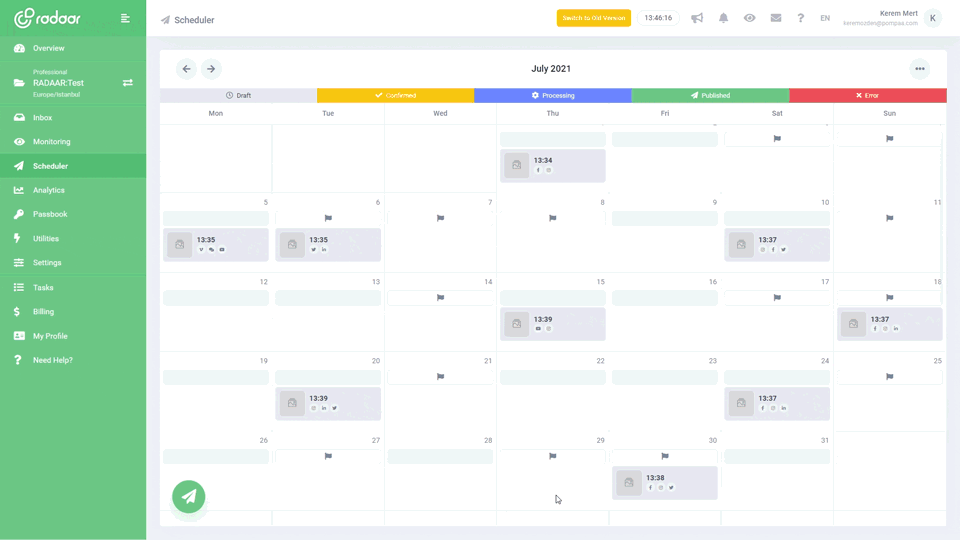Do you know the key social media KPIs every marketer should be tracking?
Discover the essential social media KPIs that every marketer should be tracking to enhance their strategy and achieve measurable success. Dive into our insightful blog post to explore these crucial metrics and learn how to effectively leverage them for your brand's growth!
LEARN MORE LAUNCH DEMO NOW In the rapidly evolving landscape of digital marketing, staying ahead of the curve often means mastering the nuances of social media analytics. As platforms like Facebook, Instagram, and Twitter continue to shape consumer behavior and brand interaction, understanding key performance indicators (KPIs) has become crucial. Gone are the days when merely having a presence on social media sufficed; today, effective marketers harness data-driven strategies to fine-tune their campaigns. But with a vast array of metrics available, how do you determine which KPIs truly impact your brand's success?
Embarking on this analytical journey can seem overwhelming, but by focusing on core KPIs, you can glean meaningful insights to propel your marketing strategies forward. These metrics offer a window into your audience's preferences and behaviors, revealing what's working and what needs adjustment. From engagement rates that spotlight your community's involvement to conversion rates that measure the effectiveness of your campaigns, each KPI offers a piece of the puzzle. Join us as we delve into the essential social media KPIs every marketer should track to optimize their efforts and drive tangible results.
Embarking on this analytical journey can seem overwhelming, but by focusing on core KPIs, you can glean meaningful insights to propel your marketing strategies forward. These metrics offer a window into your audience's preferences and behaviors, revealing what's working and what needs adjustment. From engagement rates that spotlight your community's involvement to conversion rates that measure the effectiveness of your campaigns, each KPI offers a piece of the puzzle. Join us as we delve into the essential social media KPIs every marketer should track to optimize their efforts and drive tangible results.
Table of Contents
- Why is social media KPI tracking important?
- How can reach be measured effectively?
- What does engagement rate say about your brand?
- Why are shares a valuable KPI to track?
- Can follower growth rate predict future success?
- What role does click-through rate play?
- How can bounce rate affect your social media strategy?
- Why does conversion rate matter in social media?
- Ready to elevate your social media marketing with KPI tracking?
Why is social media KPI tracking important?
Tracking social media KPIs is crucial because it helps marketers understand the effectiveness of their strategies and campaigns. By keeping an eye on these metrics, marketers can identify what's working and what isn't, enabling them to make informed decisions to optimize their efforts. Additionally, analyzing KPIs allows for better allocation of resources and budget, ensuring a higher return on investment. Ultimately, understanding these metrics fosters stronger connections with audiences, leading to increased brand loyalty and growth.
How can reach be measured effectively?
Measuring reach effectively involves looking at the number of unique users who see your content, providing valuable insight into how far your message is spreading. To track this accurately, make use of in-built analytics tools on each social media platform, which offer metrics like impressions, audience demographics, and reach statistics. Furthermore, using third-party analytics tools can help you consolidate data from multiple platforms for a more comprehensive view. Consistently monitoring these metrics enables marketers to adjust their strategies to enhance visibility and maximize audience engagement.
What does engagement rate say about your brand?
Engagement rate is like a health check-up report for your brand. It tells you how well your audience is interacting with your content across social media platforms. The better the engagement rate, the more your audience is resonating with your posts, be it through likes, shares, comments, or other interactions. Essentially, a high engagement rate signifies that your content is not only being seen but is also compelling enough for viewers to take action. This metric can therefore act as a mirror reflecting the quality and relatability of your brand's social media presence.
Furthermore, analyzing the engagement rate can help marketers identify what content works best and understand their audience’s preferences better. Posts with high engagement can guide your future content strategies by highlighting successful themes and tones. Conversely, low engagement rates can serve as a warning sign that changes might be needed to align more closely with your audience's interests. Monitoring this metric over time allows brands to fine-tune their approach and maintain a strong, dynamic connection with their audience, ultimately enhancing brand loyalty and trust.
Furthermore, analyzing the engagement rate can help marketers identify what content works best and understand their audience’s preferences better. Posts with high engagement can guide your future content strategies by highlighting successful themes and tones. Conversely, low engagement rates can serve as a warning sign that changes might be needed to align more closely with your audience's interests. Monitoring this metric over time allows brands to fine-tune their approach and maintain a strong, dynamic connection with their audience, ultimately enhancing brand loyalty and trust.
Why are shares a valuable KPI to track?
Shares are a valuable KPI to track because they amplify your content's reach and visibility, essentially turning your audience into brand ambassadors. When users share your content, it indicates a high level of engagement and approval, suggesting that your message resonates well with your target demographic. This organic distribution can lead to increased brand awareness and potentially drive more traffic to your website, enhancing opportunities for conversions. Moreover, analyzing which types of content get shared most frequently can provide valuable insights into audience preferences, helping to refine future social media strategies.
Can follower growth rate predict future success?
The follower growth rate, while an important metric, should not be viewed as the sole predictor of future success in social media marketing. A steadily growing follower count can indeed indicate that your content is resonating with your target audience and that your brand is gaining traction. It reflects an increasing interest and engagement from users, which can be a positive sign of your brand’s potential. However, equating follower growth directly with future success can be misleading if not paired with quality engagement and conversions. It's crucial to remember that a large following doesn’t necessarily guarantee a loyal or active community.
Instead, the follower growth rate should be seen as one piece of the bigger picture. Marketers should also focus on the quality of interactions and the level of engagement that their followers provide. Metrics like engagement rate, conversion rate, and click-through rate are invaluable for painting a more complete picture of your brand’s social media success. Followers might push the numbers up, but if they are not interacting with your content or moving down the sales funnel, their impact can be minimal. Thus, while a growing following is a promising start, it’s the combination of growth with consistent engagement and meaningful interaction that acts as a strong indicator of future success in the social media landscape.
Instead, the follower growth rate should be seen as one piece of the bigger picture. Marketers should also focus on the quality of interactions and the level of engagement that their followers provide. Metrics like engagement rate, conversion rate, and click-through rate are invaluable for painting a more complete picture of your brand’s social media success. Followers might push the numbers up, but if they are not interacting with your content or moving down the sales funnel, their impact can be minimal. Thus, while a growing following is a promising start, it’s the combination of growth with consistent engagement and meaningful interaction that acts as a strong indicator of future success in the social media landscape.
What role does click-through rate play?
Click-through rate (CTR) is a crucial social media KPI that every marketer should pay attention to, as it measures the effectiveness of your content in driving engagement. A high CTR indicates that your audience finds your posts enticing enough to click through to learn more, whether it’s visiting your website, reading a blog, or making a purchase. By analyzing CTR, marketers can understand which types of content resonate most with their target audience, helping to refine strategies and improve campaign performance. Ultimately, focusing on CTR allows marketers to ensure that their social media efforts lead to meaningful interactions and conversions, maximizing their return on investment.
How can bounce rate affect your social media strategy?
Bounce rate is a crucial metric that can shed light on the effectiveness of your social media strategy by indicating how well your content engages visitors. A high bounce rate might suggest that visitors aren't finding the content relevant, compelling, or easy to navigate, prompting them to leave quickly. This insight can help you tweak your content strategy, ensuring that the posts shared on social media align better with your audience’s interests and expectations. By focusing on reducing bounce rates, you can enhance user experience, increase engagement, and ultimately drive more conversions from your social media efforts.
Why does conversion rate matter in social media?
Conversion rate is crucial in social media because it directly measures how effectively your content turns followers into customers or leads. By tracking this KPI, marketers can gauge the success of their campaigns and make data-driven decisions to refine their strategies. A high conversion rate means that your audience is not only engaged but also motivated to take the desired action, such as making a purchase or signing up for a newsletter. This insight allows you to tailor your content to better meet your audience's needs and optimize your return on investment.
Ready to elevate your social media marketing with KPI tracking?
Ready to elevate your social media marketing with KPI tracking? By honing in on the right KPIs, you're not just measuring success—you're shaping it. Understanding and analyzing metrics such as engagement rate, reach, conversion rates, and customer feedback gives you the real-time insights needed to refine your strategies. Consistent tracking allows marketers to identify trends, spot opportunities, and make data-driven decisions that align with overall business goals. It transforms your social media presence from a mere company voice into a powerhouse of effective communication and audience interaction.
Taking the time to master your KPIs can be the game-changer in a marketing strategy. Investing in tools and software that streamline KPI analysis can simplify the process, allowing you to respond swiftly to the ever-changing digital landscape. Remember, the goal is to build a community around your brand, foster relationships, and drive engagement, which ultimately leads to growth. As you track your progress and adapt your strategies, you’re not just keeping up with trends; you're setting them. Ready to harness this power? Dive into KPI tracking today and watch your social media influence soar.
Taking the time to master your KPIs can be the game-changer in a marketing strategy. Investing in tools and software that streamline KPI analysis can simplify the process, allowing you to respond swiftly to the ever-changing digital landscape. Remember, the goal is to build a community around your brand, foster relationships, and drive engagement, which ultimately leads to growth. As you track your progress and adapt your strategies, you’re not just keeping up with trends; you're setting them. Ready to harness this power? Dive into KPI tracking today and watch your social media influence soar.
SOCIAL MEDIA SCHEDULER
Plan and publish...
Plan and publish your content for Facebook, Instagram, Twitter, and LinkedIn from one simple dashboard.
LEARN MORE FREQUENTLY ASKED QUESTIONS
What is social media management platform?
RELATED BLOG POSTS
All the tips & tricks you'll need...
Get the fresh tips and tricks you'll need to ace social media marketing.












